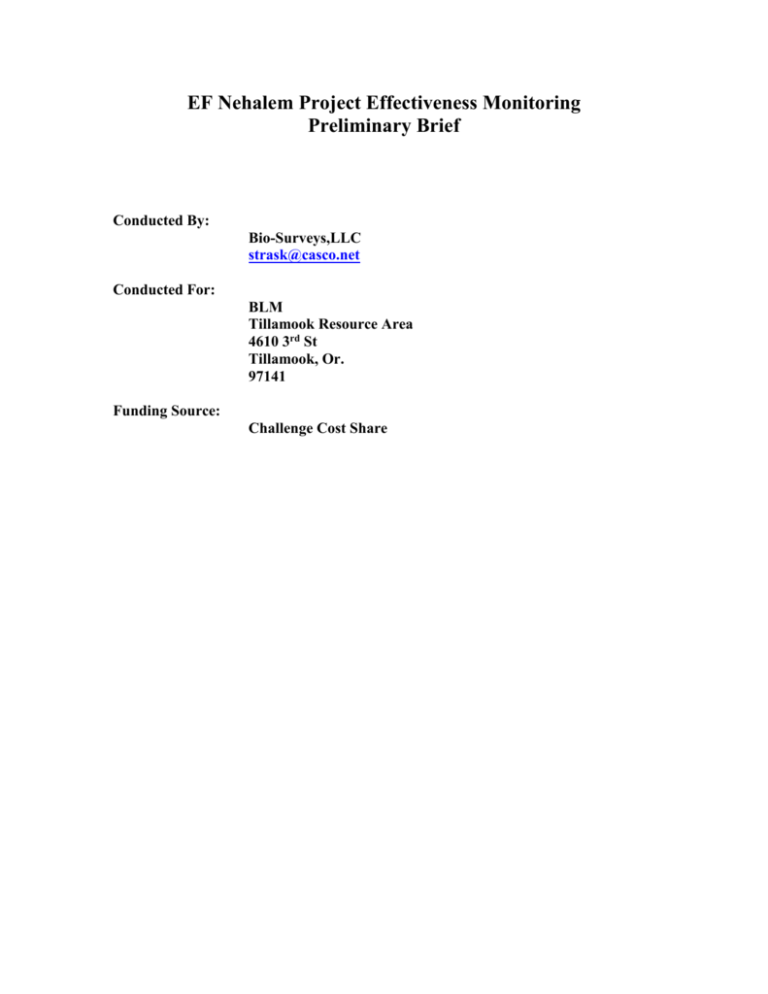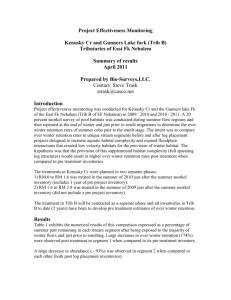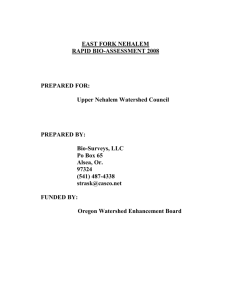EF Nehalem Project Effectiveness Monitoring Preliminary Brief
advertisement

EF Nehalem Project Effectiveness Monitoring Preliminary Brief Conducted By: Bio-Surveys,LLC strask@casco.net Conducted For: BLM Tillamook Resource Area 4610 3rd St Tillamook, Or. 97141 Funding Source: Challenge Cost Share Introduction This review of project effectiveness is related to instream structure placements designed and implemented by BLM staff from the Tillamook Resource Area in Kenusky Cr and Gunners Lake Fk (Trib B) of the EF Nehalem. In August of 2009, approximately 65 full length conifer logs were placed by track excavator and spider. Placements occurred on BLM ownership only and began at approximately RM 1.6 and extended to RM 3.7 (a short section of private industrial forest land was left untreated between the BLM treated segments). Logs were placed in 20 different structure complexes in the lower segment and an additional 27 riparian conifers were felled into the active channel in the upper segment. The combined treatment areas (including the skipped private block) extended approximately 2.1 miles. All wood placements were designed to encourage floodplain interaction, trap transient wood and substrate resources and to eventually aggrade the active channel. All of these responses conceptually leading to the improvement of the over winter retention of juvenile salmonids in tributaries of the EF Nehalem and an increase in upper basin smolt production. To provide an evaluation of project effectiveness for the goal of increasing upper basin smolt production, a summer / winter comparison of abundance was conducted by Bio-Surveys, LLC. This inventory involved the snorkeling of a sub sample of pool habitats (20 percent) during both the summer and winter in identical stream reaches to estimate the seasonal population of coho parr. The differential between the summer and post winter populations was the primary metric utilized to quantify differences in the streams capacity for retaining juveniles in headwater reaches until smoltification. Winter snorkel inventories were conducted at night at the end of February to most accurately represent the population size after winter and just prior to smolting. Results Three unique stream reaches were identified for current and future LWD treatments. The 2.1 mile segment of Kenusky Cr treated with LWD during the summer of 2009 did not receive a pre treatment assessment of over winter retention and comparisons to the untreated reach of Kenusky although potentially representative should be considered inappropriate due to distinct differences in channel morphology (gradient). The other two stream segments (lower Kenusky and Trib B of EF Nehalem) now have a pre treatment assessment of over winter retention and direct pre and post project comparisons will be applicable after successful completion of additional log structure placements in these two reaches. The attached Excel summary table produces seasonal population estimates (summer and winter) utilizing both summer and winter electrofish calibration factors developed by ODFW Research on both summer and winter snorkel inventories on Lobster Cr in the Alsea basin. These calibration factors are as follows: Summer all pool complexities……………….. (Observed) x (1.20) = N Winter low – medium pool complexities……. (Observed) x (1.23) = N Winter high complexity……………………… (Observed) x (1.89) = N This summary represents the first year of a multi year effort to monitor project effectiveness. Two pre project reaches are represented here and one post project reach without a pre project inventory. It is tempting to view the first 1.6 mile segment of Kenusky Cr as a potential control for the treated reach of Kenusky (RM 1.6 – 3.7); however differences in channel morphology suggest that a direct comparison may be inappropriate. An assumption was made that the primary tributaries of both Kenusky Cr and Trib B of EF Nehalem (this includes Trib A Kenusky and Trib B1 of Trib B) exhibit steep gradients with plunge pool dominated habitats and that coho observed summer rearing in this tributaries would be dropping into mainstem habitats after the first fall freshets. This assumption led to increasing the size of the mainstem summer population estimate by the number of additional coho observed rearing in its tributaries. Included as deliverables of this contract are the raw summer and winter data archived in an Access database and an Excel workbook summarizing the results of the summer / winter comparison. For the development of a GIS mapping layer, the end point of the winter RBA inventory was documented at 45 52 698 / 123 03 584.







